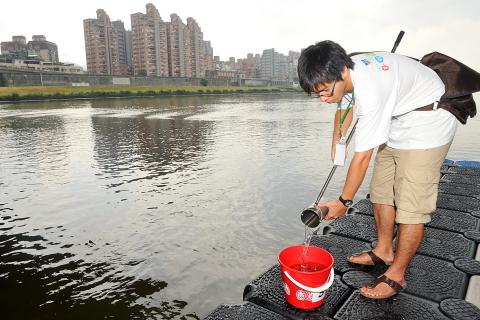More than 600 people yesterday gathered at Dajhih Bridge in Taipei to test the water quality of the Keelung River as part of an activity organized by the Environmental Protection Administration (EPA) for World Water Monitoring Day (WWMD).
WWMD is an international outreach education program that aims to build public awareness and involvement in protecting water resources around the world by encouraging citizens to conduct basic monitoring of local water bodies.
The International Water Association (IWA) and the US Environmental Protection Agency co-organized the first worldwide program in 2003 and now the annual programs are co-organized by two non--governmental organization, the IWA and the Water Environment Federation.

Photo: Chien Jung-fong, Taipei Times
The number of countries that participate in the annual monitoring program has risen from 24 in 2003 to 85 this year, with more than 200,000 participants worldwide.
EPA Minister Stephen Shen (沈世宏) said Taiwan has participated in this program since its inaugural year and each year the number of participants has increased, showing that more people are becoming aware of water quality.
Because of the different time zones, Taiwan’s event inaugurated this year’s WWMD, he said.
“Each and every one of us has a role to take the right step in the right direction, even a small step, we all have a role, this is the key message that I want to convey to everyone on behalf of the IWA,” IWA senior vice-president Helena Alegre said.
Roberta Savage, the founder of WWMD and executive director of Rivanna Conservation Society in Virginia in the US, said she began the program 10 years ago.
“Thinking about the children and young people, who will be responsible for our environment in this next century, I wanted to bring young children to the water to understand the importance of keeping our water clean,” she said.
She said water testing and monitoring was a fun and interesting way for young people to be involved and learn about water protection. She said they often understand that if they were a fish in the water, then too much acid would hurt, insufficient oxygen would make it hard to breathe, too much pollution would make it difficult to see and too much heat would be unbearable.
The hundreds of adults, teenagers and children were divided into 35 teams, and each team fetched two buckets of river water for testing. The teams used a basic test kit to examine the level of dissolved oxygen, acidity, turbidity and the temperature of the water.
An elementary-school student held a tube with light green water in it after dissolving the pH reagent tablet in it, and closely compared it to the color chart. She found the pH level of the water to be 7, which is neutral and safe.
Among the groups, Hsinchu City’s Yu-Hsien Junior High School teacher Hsiao Ming-yu (蕭名瑜) joined her former and current students in the event.
She said her former student joined Savage’s water monitoring workshop in New Orleans in 2005. They had the rare experience of testing water quality in wetlands, rivers and the sea, while also witnessing the city in the aftermath of Hurricane Katrina.
Her former students, now university freshmen, said the experience helped them understand the world’s environment and natural disasters, and also gave them more confidence in presenting their thoughts.
Savage said the young participants in the program were “fantastic” and that she hoped more people would recognize that teachers, schools and parents must all embrace the idea of young students participating in these programs and learning to be responsible for the environment.

The brilliant blue waters, thick foliage and bucolic atmosphere on this seemingly idyllic archipelago deep in the Pacific Ocean belie the key role it now plays in a titanic geopolitical struggle. Palau is again on the front line as China, and the US and its allies prepare their forces in an intensifying contest for control over the Asia-Pacific region. The democratic nation of just 17,000 people hosts US-controlled airstrips and soon-to-be-completed radar installations that the US military describes as “critical” to monitoring vast swathes of water and airspace. It is also a key piece of the second island chain, a string of

A magnitude 5.9 earthquake that struck about 33km off the coast of Hualien City was the "main shock" in a series of quakes in the area, with aftershocks expected over the next three days, the Central Weather Administration (CWA) said yesterday. Prior to the magnitude 5.9 quake shaking most of Taiwan at 6:53pm yesterday, six other earthquakes stronger than a magnitude of 4, starting with a magnitude 5.5 quake at 6:09pm, occurred in the area. CWA Seismological Center Director Wu Chien-fu (吳健富) confirmed that the quakes were all part of the same series and that the magnitude 5.5 temblor was

Taiwan will now have four additional national holidays after the Legislative Yuan passed an amendment today, which also made Labor Day a national holiday for all sectors. The Chinese Nationalist Party (KMT) and Taiwan People’s Party (TPP) used their majority in the Legislative Yuan to pass the amendment to the Act on Implementing Memorial Days and State Holidays (紀念日及節日實施辦法), which the parties jointly proposed, in its third and final reading today. The legislature passed the bill to amend the act, which is currently enforced administratively, raising it to the legal level. The new legislation recognizes Confucius’ birthday on Sept. 28, the

The Central Weather Administration has issued a heat alert for southeastern Taiwan, warning of temperatures as high as 36°C today, while alerting some coastal areas of strong winds later in the day. Kaohsiung’s Neimen District (內門) and Pingtung County’s Neipu Township (內埔) are under an orange heat alert, which warns of temperatures as high as 36°C for three consecutive days, the CWA said, citing southwest winds. The heat would also extend to Tainan’s Nansi (楠西) and Yujing (玉井) districts, as well as Pingtung’s Gaoshu (高樹), Yanpu (鹽埔) and Majia (瑪家) townships, it said, forecasting highs of up to 36°C in those areas